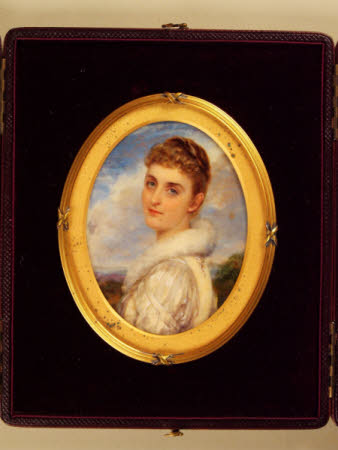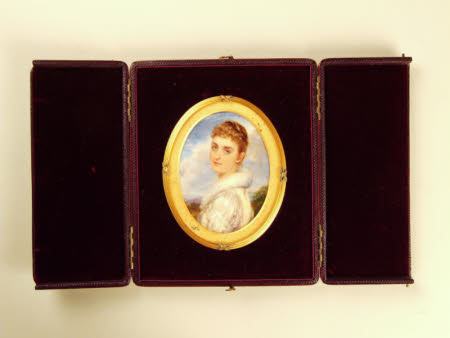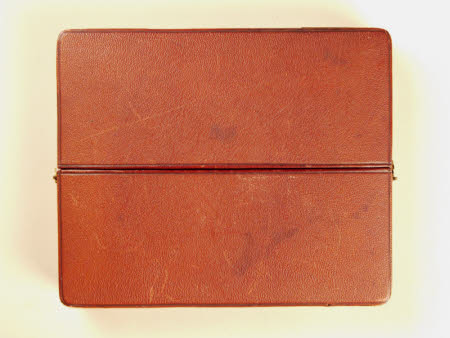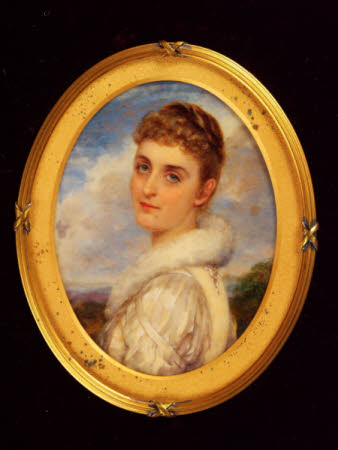Mrs Collet, possibly Nina Emma Caroline Theobald, Lady Collet (d.1922)
Annie Dixon (Horncastle 1817 - 1901)
Category
Art / Miniatures
Date
1891
Materials
Watercolour on ivory
Measurements
89 x 66 mm
Order this imageCollection
Dunham Massey, Cheshire
NT 936727
Caption
Annie Dixon was a prolific miniature portrait painter. A favourite of Queen Victoria, Dixon was commissioned to paint many royal portraits. Her talent (and moderate prices) ensured that she continued to work, despite competition following the introduction of photography. Dixon was born in Horncastle, Lincolnshire, and was the eldest of seven children – their father was a corn merchant. In her 1876 book on women artists, Ellen Clayton notes that ‘family affairs rendered it necessary that, early in life, Miss Dixon should make her own way in the world’. She received some tuition in miniature painting from Magdalena Ross (1801–74), and by 1851 was working (probably handcolouring photographs) at the studio of Mrs Ann Cooke (1796–1870) in Hull – thought to be one of the first commercial photography studios opened by a woman. By 1859, when Dixon received her first royal portrait commission from Queen Victoria, she had established her reputation as a miniature portrait artist – more than 20 examples of her work are in the Royal Collection. No doubt buoyed by her regal patron, Dixon built a noble and aristocratic clientele and enjoyed a long, highly productive career. She had a particular affinity for depicting children, and painted Adelbert Wellington Brownlow Cust, 3rd Earl Brownlow of Belton House, Lincolnshire, as a boy (NT 435997) and again as a young man, 14 years later (NT 435995). For over 30 years she also showed her best work at the annual Royal Academy exhibitions. Clayton wrote, ‘Miss Dixon loves her work, finding in it her greatest pleasure, and seldom gives herself a holiday.’ This insatiable drive to paint meant Dixon continued to take commissions into her seventies, including this luminous portrait probably of Lady Collet, stopping only when her eyesight began to fail.
Summary
Portrait miniature, watercolour on ivory, Mrs Collet, possibly Nina Emma Caroline Theobald, Lady Collet (d. 1922), by Annie Dixon (Horncastle 1817-1901). 1891. Oval. The sitter appears in a white dress with fur collar, and has blue eyes, fair hair and is aged about twenty five. signed 'A Dixon Sepr. 1891' In 1888 Nina Emma Caroline Theobald, the daughter of Rev. Charles Theobald and sister of Elizabeth Louisa Penelope Theobald, Countess of Stamford, married as his first wife, Mark Edlmann Collet who became, in 1905, Sir Mark Edlmann Collet, 2nd Baronet.
Provenance
Stamford collection; devised to the National Trust by Roger Grey, 10th Earl of Stamford (1896-1976).
Marks and inscriptions
A Dixon Sepr. 1891 (signed)
Makers and roles
Annie Dixon (Horncastle 1817 - 1901), miniaturist
References
Conroy, Rachel, Women Artists and Designers at the National Trust, 2025, pp. 120-123



